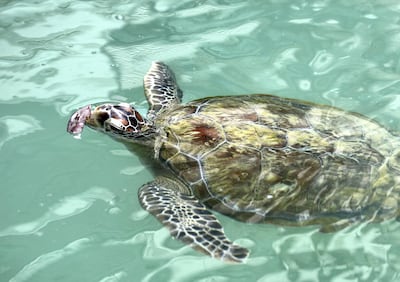A turtle rescued by a Sharjah sheikh has been moved from Burj Al Arab Aquarium to the Turtle Rehabilitation Sanctuary at Jumeirah Al Naseem.
Farah, as the reptile is now called, has made extraordinary progress since having a flipper amputated in March.
Sheikh Fahim Al Qasimi travelled with Farah from Burj Al Arab and carefully released her into the water of the lagoon.
"She's so quick at swimming now," he said, "but it's a bittersweet moment."
"While I'm thrilled at her recovery and seeing her swim so confidently," he said, "it is still a shame that her amputated flipper was directly caused by our disregard for the environment.
"Nevertheless, I owe a huge amount of gratitude to the Environment and Protected Areas Authority in Sharjah, [her vet] Dr Panos and the team at the Burj Al Arab for saving Farah."
Farah is recovering well, said Tristan Delmas, hotel manager at Burj Al Arab.
"She is now able to maintain her buoyancy and is also eating and swimming well.
"As expected, she recovered fast and safely and we can’t wait for her to be released into the wild once ready.
"Farah has been transferred to the turtle lagoon at Jumeirah Al Naseem where the team can monitor the final stages of rehabilitation before she can be released back into her natural habitat after being given the all-clear."
The 20-year-old turtle required surgery after getting tangled up in fishing line off Sir Bu Nuair, a protected area 100 kilometres west of Dubai.
Sheikh Fahim spotted Farah struggling and dived seven metres down to investigate.
About two metres from the surface, he discovered that the line wrapped around the turtle’s neck and flipper was attached to the seabed and was holding her down.
Treading water and holding his breath, he managed to cut the turtle free and bring her to the surface.
Turtles can hold their breath for between four and seven hours, but eventually drown if they are trapped underwater.
Dr Panos Azmanis from the Dubai Falcon Hospital operated on Farah at Burj Al Arab Aquarium but was sadly unable to save her flipper, which had to be amputated.
Farah has been released into the sea-fed lagoon at Jumeirah Al Naseem where she will have more space to swim and build up her strength.
Successful turtle rehabilitation
The rescued turtles in the sanctuary are fed on a diet of squid and monitored in the final stages of their rehabilitation, before being released back into UAE waters.
The marine biologists at the Burj Al Arab Aquarium hope Farah will be released into the wild after the summer.
The team has successfully returned more than 2,000 turtles to the Arabian Gulf from all over the UAE since the project's inception in 2004, with an average rescue of 225 turtles in recent years, Mr Delmas said.
"Every turtle that has come in and had the chance to recover is a success.
"A few examples include a green turtle named Hope that came in with a fully broken carapace (shell) in 2017.
"She was taken care of and released back into the wild in November 2018.
"In 2019, we received a hawksbill with collapsed lungs.
"After many months of rehabilitation, he also recovered and was released on June 16, 2019."
The Dubai Turtle Rehabilitation Project is run in collaboration with Dubai’s Wildlife Protection Office, with veterinary support provided by the Dubai Falcon Hospital and the Central Veterinary Research Laboratory.
The project managers say it is currently the only scheme of its kind in the Middle East and Red Sea region.


























